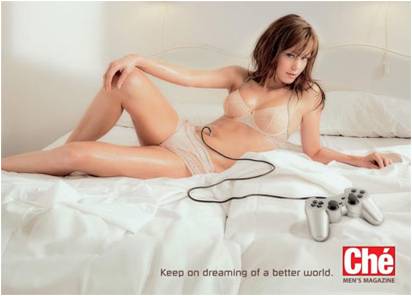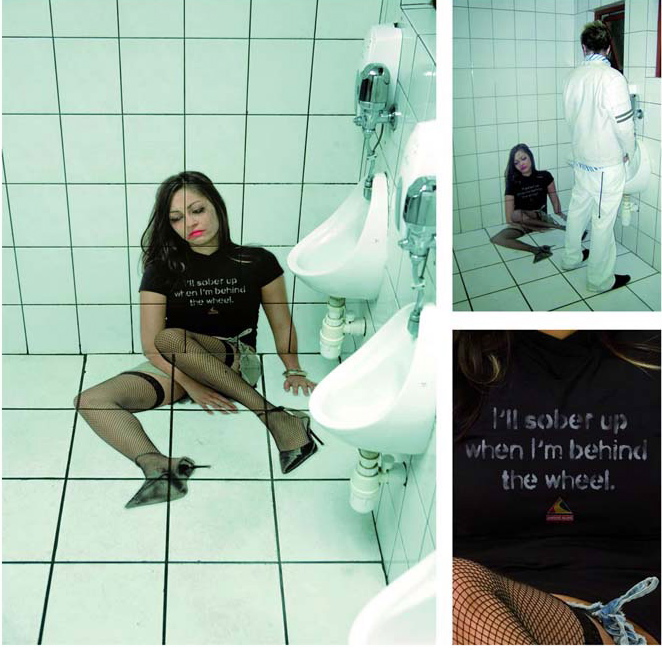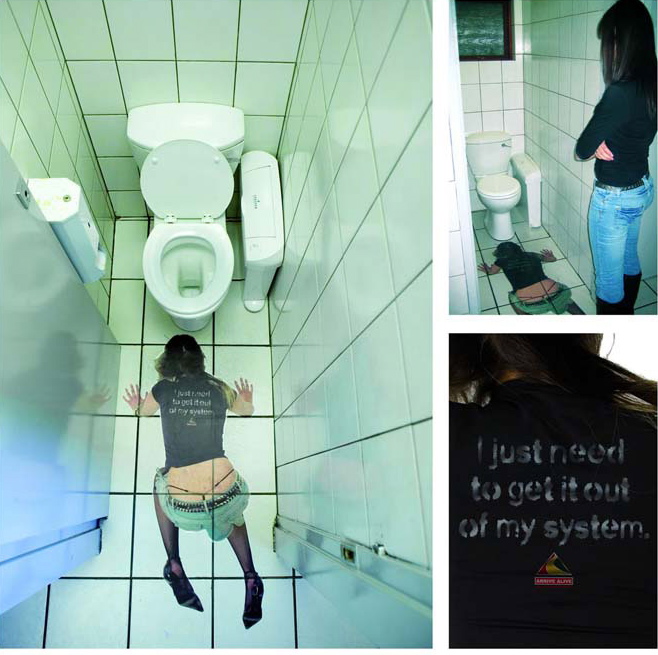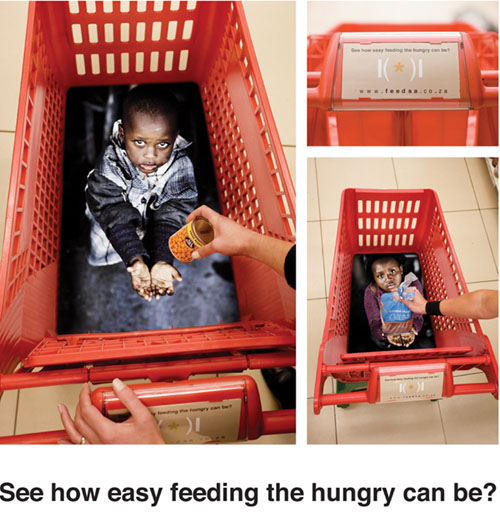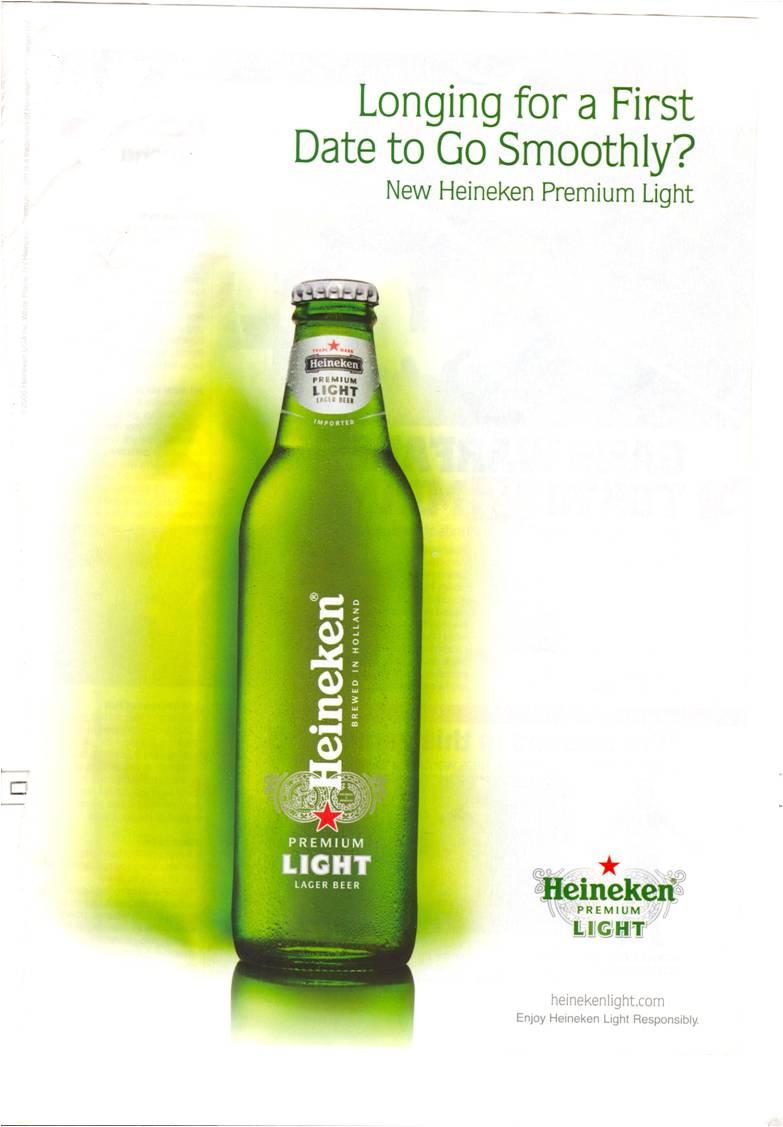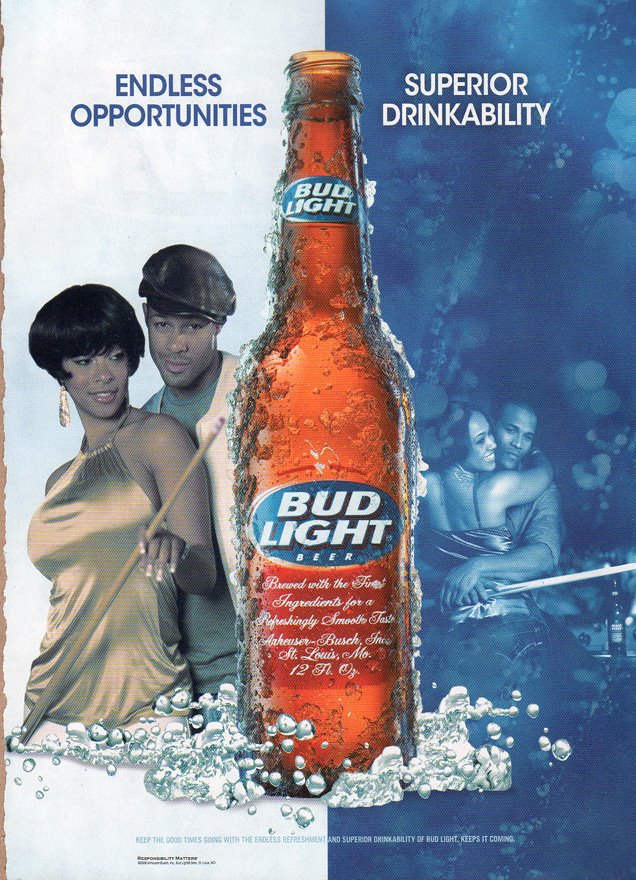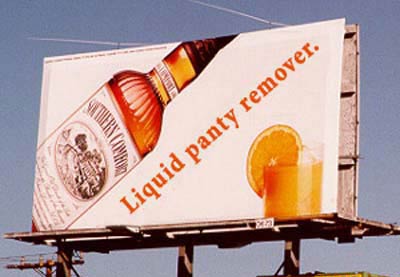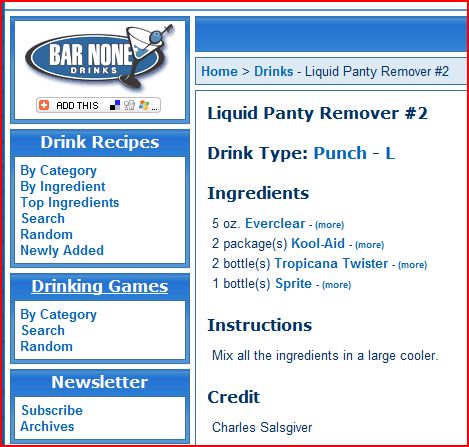sex
Arrive Alive is an anti-drunk driving organization. As part of one educational campaign, they designed these…stickers? posters? stick-ons? I’m not sure what you call them, but things to stick on the wall of public bathrooms to make people think before driving drunk. Here are two examples (found at copyranter):
I don’t quite know what to make of these. I mean, they definitely get your attention. But I also question the outfit they chose to show her in–what’s with sexing her up so much? With fishnet thigh-highs, a visible g-string, and stilettos, no less. And as copyranter points out, for the type of guys (and I know this is a specific group–this isn’t referring to men in general) who look for drunk women to have sex with, I think that top image might have a totally different effect than the organization is getting at. Maybe that’s part of the point–to scare women with the threat of making bad sexual choices (or being forced into sexual activities) while drunk. But then why put it in the men’s bathroom? I’m kind of stumped, really. Readers?
Just a side note, I’m thinking the poster at the top, next to the urinal, is just going to get peed on a lot (after all, there are already lots of urinals shaped like women), while the bottom one is likely to get puked on now and then.
This just strikes me as another example of a PSA that manages to be creepy without necessarily being effective.
Here’s a somewhat similar example. These ads are for Feed SA, a New Zealand-based organization to provide food to people in South Africa. They paid some supermarkets to put these ads in shopping baskets (images posted by copyranter at Animal New York):
I guess part of the point here is to make people feel uncomfortable while they’re filling their baskets with lots of food, in the hopes that they’ll go home and make a donation. And that, in and of itself, doesn’t surprise me; I used to foster dogs for a dog rescue, and let me tell you, we weren’t above occasionally using guilt or desperate appeals if we were in dire shape, and I think it’s a fairly standard (though not necessarily effective) practice among charity organizations. I’m not entirely certain why I find them disconcerting. Maybe there’s no good reason for it.
Readers, what do you think?
Last year the British Heart Foundation released this ad (found at the Mail Online) encouraging people to get a half hour of exercise each day:
It sparked some complaints, presumably because it says sex so openly and has a naked man in it. But it’s kinda neat to see an ad that shows middle-aged people with bodies that don’t necessarily fit our cultural beauty ideals, and acknowledging that they have sex. Of course we know people in their 40s and 50s have sex, but the images we get of women in those age groups being sexual usually depicts them as MILFs, not average women. I think many people are comfortable with the idea that men would be having sex later in life, but we often see them paired with much younger, hot women, not women their own age.
I went to BHF’s website. There is a page called Sex and Heart Disease. They also have a DVD available about sex and recovering from heart disease.
You might use these for a discussion of older couples and sexality, and how uncomfortable we are thinking about older people having sex in our culture. It would be a good topic to tie in to myths about sexual activity among older people. According to this Washington Post article, about 75% of people aged 57-85 who have partners are sexually active. About half of those aged 75-85 who are sexually active report having sex 2-3 times per month, and nearly a quarter have sex at least once a week. And yet our cultural images are generally that either older people don’t have sex at all, or that when they do, it’s gross. We also often assume that all older men have problems with impotence; certainly many do, but it’s not universal and often occurs much later in life that we might expect.
The American Psychological Association has a bibliography of journal articles related to older people and sexuality available here. Although they’re all from a psych perspective, they might be useful for gathering some basic data about the topic.
And, as I tell my students when we talk about aging and sex, I wouldn’t enter Grandma and Grandpa’s bedroom without knocking.
See also this post about a company that used stories of happily sexual older couples to sell mortgages.
Gwen Sharp is an associate professor of sociology at Nevada State College. You can follow her on Twitter at @gwensharpnv.
Rachel M. sends us this story: The cover for the 1976 Scorpions album “Virgin Killer” apparently not considered problematic enough for censorship at the time, was pulled from a Wikipedia webpage for being “a potentially illegal indecent image of a child under the age of 18.” The image, included after the jump, features a naked prepubescent girl in a provocative pose:
Miguel E. sent us a link to a story about Natural High, a Japanese company that reportedly makes “extreme” pornography. The producer, Sakkun, felt bad that many children in Africa live in poverty and so he sent a porn star to Kenya to have sex with African men (on film, of course). The company gave a Kenyan aid organization one million yen (around $10, 800 U.S.) and 1,000 more (currently about $10.77 U.S.) is donated for every DVD sold (story here). Images and discussion after the jump:
Kona Grill specializes in “imaginative meals.” In their ad campaign (discovered here), they sexualize their mixing of usually segregated culinary traditions (“East meets West”). Here they put a fork and chopsticks in bed together:
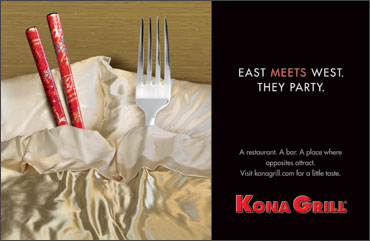
Their food, apparently, is like interracial sex. This is interesting in itself, but the copy goes further. It reads:
A restuarant. A bar. A place where opposites attract. Visit konagrill.com for a little taste.
So not only are East and West (or Asians and Americans) different, they’re “opposites.” Such advertising not only fetishizes interracial relationships, but it reinforces the idea that race and culture are such powerful and defining characteristics that people from the East and the West could not possibly have anything in common (except sex, of course).
I’ve never been able to find a picture of it, but when I was in graduate school (not so long ago) and living in Madison, Wisconsin, there was an ad for Bacardi on the side of a city bus that said: “Bacardi, the Ultimate Wingman.” A wingman is a friend who helps you get laid, so the not-so-subtle message of the ad was: “get’er drunk and she’ll do ya!”
Here are two ads that have, essentially, the same message (the first was given to me by my student, Bo; the second was found here).
This one could be interpreted as, “Drink Heineken so you won’t be nervous,” or, “Drink Heineken so you’ll get what you want without any trouble.”
In this ad for Bud Light, with the copy “Endless Opportunities,” the man and the viewer of the ad exchange a conspiratorial gaze, while the woman glances to the side or, perhaps, back at him. Is the message, “If I’m drinking Bud Light, anything could happen,” or “If she’s drinking Bud Light, anything could happen”?
See also this ad for, ostensibly, a date rape drug.
An anonymous commenter pointed us to billboard below advertising Southern Comfort as a “liquid panty remover.” Before we get our panties in a bunch, I should point out it’s a hoax (thanks, Vidya):
So this is a hoax. It still trivializes trying to manipulate women by getting them drunk (at best) and date rape (at worst), but it could have been produced by any yahoo with a computer. Yahoos with computers can do anything they like, I’d be more concerned if it was circulated by the company that markets Southern Comfort.
That said, in looking it up to discover it was a hoax, I discovered about a dozen recipes for mixed drinks called “Liquid Panty Remover.” Here are some screen shots:
So I guess there was good news and bad news.
NEW! In this ad, sent in by HighJive of MultiCultClassics, the brandy is the “producer.” The producer is the person who makes a film happen. Thus the sexy scene that is about to ensue is attributed to the alcohol. (Also notice the linking of the product with pornography.)
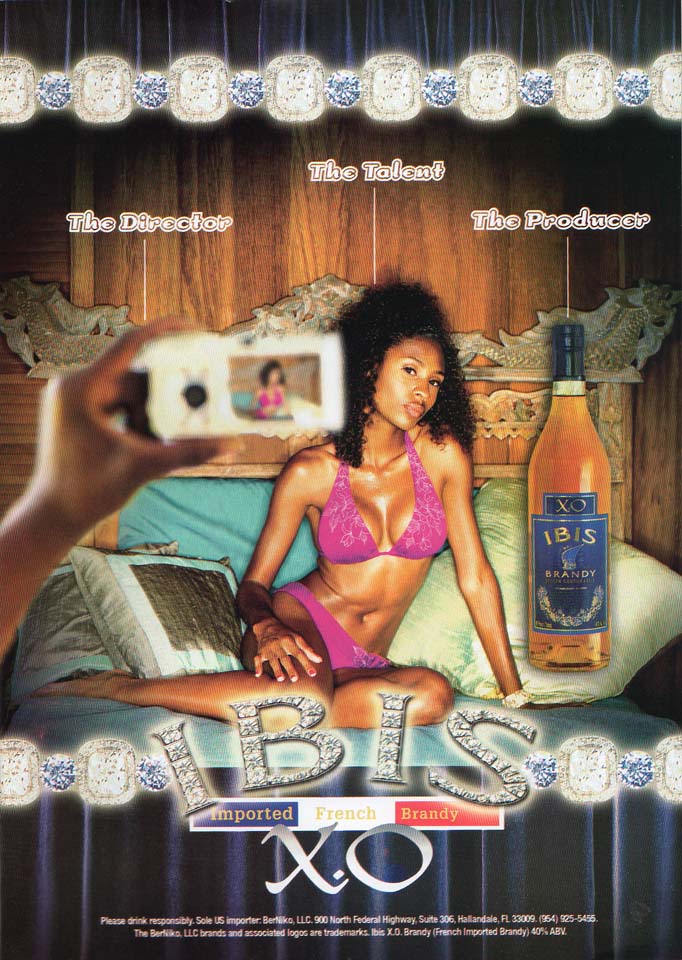
Also in sexualizing alcohol: “nice cans,” “she loves a cockatoo,” sexy robots (see here and here), “aged longer, tastes smoother,” and, um, this one.
Arrive Alive is an anti-drunk driving organization. As part of one educational campaign, they designed these…stickers? posters? stick-ons? I’m not sure what you call them, but things to stick on the wall of public bathrooms to make people think before driving drunk. Here are two examples (found at copyranter):
I don’t quite know what to make of these. I mean, they definitely get your attention. But I also question the outfit they chose to show her in–what’s with sexing her up so much? With fishnet thigh-highs, a visible g-string, and stilettos, no less. And as copyranter points out, for the type of guys (and I know this is a specific group–this isn’t referring to men in general) who look for drunk women to have sex with, I think that top image might have a totally different effect than the organization is getting at. Maybe that’s part of the point–to scare women with the threat of making bad sexual choices (or being forced into sexual activities) while drunk. But then why put it in the men’s bathroom? I’m kind of stumped, really. Readers?
Just a side note, I’m thinking the poster at the top, next to the urinal, is just going to get peed on a lot (after all, there are already lots of urinals shaped like women), while the bottom one is likely to get puked on now and then.
This just strikes me as another example of a PSA that manages to be creepy without necessarily being effective.
Here’s a somewhat similar example. These ads are for Feed SA, a New Zealand-based organization to provide food to people in South Africa. They paid some supermarkets to put these ads in shopping baskets (images posted by copyranter at Animal New York):
I guess part of the point here is to make people feel uncomfortable while they’re filling their baskets with lots of food, in the hopes that they’ll go home and make a donation. And that, in and of itself, doesn’t surprise me; I used to foster dogs for a dog rescue, and let me tell you, we weren’t above occasionally using guilt or desperate appeals if we were in dire shape, and I think it’s a fairly standard (though not necessarily effective) practice among charity organizations. I’m not entirely certain why I find them disconcerting. Maybe there’s no good reason for it.
Readers, what do you think?
Last year the British Heart Foundation released this ad (found at the Mail Online) encouraging people to get a half hour of exercise each day:
It sparked some complaints, presumably because it says sex so openly and has a naked man in it. But it’s kinda neat to see an ad that shows middle-aged people with bodies that don’t necessarily fit our cultural beauty ideals, and acknowledging that they have sex. Of course we know people in their 40s and 50s have sex, but the images we get of women in those age groups being sexual usually depicts them as MILFs, not average women. I think many people are comfortable with the idea that men would be having sex later in life, but we often see them paired with much younger, hot women, not women their own age.
I went to BHF’s website. There is a page called Sex and Heart Disease. They also have a DVD available about sex and recovering from heart disease.
You might use these for a discussion of older couples and sexality, and how uncomfortable we are thinking about older people having sex in our culture. It would be a good topic to tie in to myths about sexual activity among older people. According to this Washington Post article, about 75% of people aged 57-85 who have partners are sexually active. About half of those aged 75-85 who are sexually active report having sex 2-3 times per month, and nearly a quarter have sex at least once a week. And yet our cultural images are generally that either older people don’t have sex at all, or that when they do, it’s gross. We also often assume that all older men have problems with impotence; certainly many do, but it’s not universal and often occurs much later in life that we might expect.
The American Psychological Association has a bibliography of journal articles related to older people and sexuality available here. Although they’re all from a psych perspective, they might be useful for gathering some basic data about the topic.
And, as I tell my students when we talk about aging and sex, I wouldn’t enter Grandma and Grandpa’s bedroom without knocking.
See also this post about a company that used stories of happily sexual older couples to sell mortgages.
Gwen Sharp is an associate professor of sociology at Nevada State College. You can follow her on Twitter at @gwensharpnv.
Rachel M. sends us this story: The cover for the 1976 Scorpions album “Virgin Killer” apparently not considered problematic enough for censorship at the time, was pulled from a Wikipedia webpage for being “a potentially illegal indecent image of a child under the age of 18.” The image, included after the jump, features a naked prepubescent girl in a provocative pose:
Miguel E. sent us a link to a story about Natural High, a Japanese company that reportedly makes “extreme” pornography. The producer, Sakkun, felt bad that many children in Africa live in poverty and so he sent a porn star to Kenya to have sex with African men (on film, of course). The company gave a Kenyan aid organization one million yen (around $10, 800 U.S.) and 1,000 more (currently about $10.77 U.S.) is donated for every DVD sold (story here). Images and discussion after the jump:
Kona Grill specializes in “imaginative meals.” In their ad campaign (discovered here), they sexualize their mixing of usually segregated culinary traditions (“East meets West”). Here they put a fork and chopsticks in bed together:

Their food, apparently, is like interracial sex. This is interesting in itself, but the copy goes further. It reads:
A restuarant. A bar. A place where opposites attract. Visit konagrill.com for a little taste.
So not only are East and West (or Asians and Americans) different, they’re “opposites.” Such advertising not only fetishizes interracial relationships, but it reinforces the idea that race and culture are such powerful and defining characteristics that people from the East and the West could not possibly have anything in common (except sex, of course).
I’ve never been able to find a picture of it, but when I was in graduate school (not so long ago) and living in Madison, Wisconsin, there was an ad for Bacardi on the side of a city bus that said: “Bacardi, the Ultimate Wingman.” A wingman is a friend who helps you get laid, so the not-so-subtle message of the ad was: “get’er drunk and she’ll do ya!”
Here are two ads that have, essentially, the same message (the first was given to me by my student, Bo; the second was found here).
This one could be interpreted as, “Drink Heineken so you won’t be nervous,” or, “Drink Heineken so you’ll get what you want without any trouble.”
In this ad for Bud Light, with the copy “Endless Opportunities,” the man and the viewer of the ad exchange a conspiratorial gaze, while the woman glances to the side or, perhaps, back at him. Is the message, “If I’m drinking Bud Light, anything could happen,” or “If she’s drinking Bud Light, anything could happen”?
See also this ad for, ostensibly, a date rape drug.
An anonymous commenter pointed us to billboard below advertising Southern Comfort as a “liquid panty remover.” Before we get our panties in a bunch, I should point out it’s a hoax (thanks, Vidya):
So this is a hoax. It still trivializes trying to manipulate women by getting them drunk (at best) and date rape (at worst), but it could have been produced by any yahoo with a computer. Yahoos with computers can do anything they like, I’d be more concerned if it was circulated by the company that markets Southern Comfort.
That said, in looking it up to discover it was a hoax, I discovered about a dozen recipes for mixed drinks called “Liquid Panty Remover.” Here are some screen shots:
So I guess there was good news and bad news.
NEW! In this ad, sent in by HighJive of MultiCultClassics, the brandy is the “producer.” The producer is the person who makes a film happen. Thus the sexy scene that is about to ensue is attributed to the alcohol. (Also notice the linking of the product with pornography.)

Also in sexualizing alcohol: “nice cans,” “she loves a cockatoo,” sexy robots (see here and here), “aged longer, tastes smoother,” and, um, this one.

